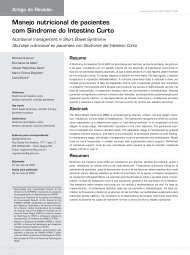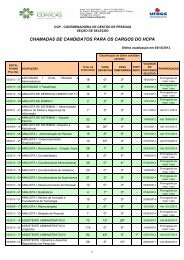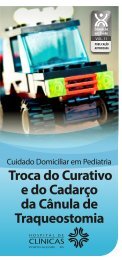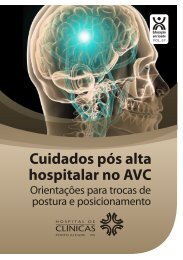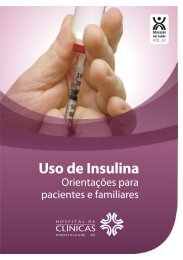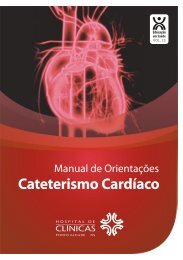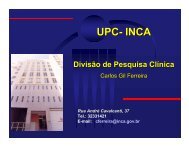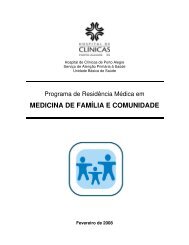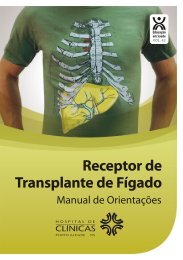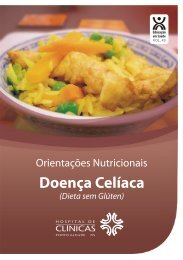Anais da 27º Semana CientÃfica - Hospital de ClÃnicas de Porto Alegre
Anais da 27º Semana CientÃfica - Hospital de ClÃnicas de Porto Alegre
Anais da 27º Semana CientÃfica - Hospital de ClÃnicas de Porto Alegre
You also want an ePaper? Increase the reach of your titles
YUMPU automatically turns print PDFs into web optimized ePapers that Google loves.
239<br />
Revista HCPA 2007; 27 (Supl.1)<br />
induzi<strong>da</strong>. Na avaliação protéica <strong>da</strong>s culturas por SDS-PAGE, foram observa<strong>da</strong>s ban<strong>da</strong>s compatíveis com os pesos moleculares <strong>da</strong>s<br />
proteínas OPN e aSFP recombinantes. O trabalho encontra-se na fase <strong>de</strong> purificação <strong>de</strong>ssas proteínas por cromatografia <strong>de</strong><br />
afini<strong>da</strong><strong>de</strong>, baseado no sistema <strong>de</strong> fusão <strong>da</strong> proteína com His-Tag.<br />
Genética Humana e Médica<br />
MONITORIZAÇÃO DE DEFEITOS CONGÊNITOS NO HOSPITAL DE CLÍNICAS DE PORTO ALEGRE (1982-2006)<br />
MÔNICA GUZINSKI RODRIGUES; GRAZIELA SMANIOTTO RODRIGUES, DIEGO DI MARCO ATAIDES, LUÍZA<br />
RENCK, FAIRUZ HELENA SOUZA DE CASTRO, CYNTHIA MOLINA, FLÁVIA OHLWEILER, TAHIANA MARQUES,<br />
VIVIAN FONTANA, LAURA HAGGEMANN, DANIELA PIRES, LEONARDO MAMARELLA, MARIAH LOPES,<br />
LUCIANA SEHN, GABRIELA MARQUES SEEGER, JÚLIO CÉSAR LOGUERCIO LEITE<br />
INTRODUÇÃO: O programa <strong>de</strong> Monitorização <strong>de</strong> Malformações Congênitas do HCPA analisa a ocorrência e fatores <strong>de</strong> risco<br />
para <strong>de</strong>feitos congênitos <strong>de</strong>s<strong>de</strong> 1982. OBJETIVOS: Fazer análise <strong>da</strong>s freqüências <strong>de</strong> <strong>de</strong>feitos congênitos (DC) no nosso hospital e<br />
então comparar com as freqüências <strong>da</strong> América Latina obti<strong>da</strong>s através do Estudo Colaborativo Latino-Americano <strong>de</strong><br />
Malformações Congênitas (ECLAMC); procurar fatores <strong>de</strong> risco associados a DC com freqüências mais altas. MATERIAL E<br />
MÉTODOS: Estudo <strong>de</strong> base hospitalar. Analisamos todos os recém-nascidos vivos (RNV) e natimortos (NM) com mais <strong>de</strong> 500g<br />
nascidos <strong>de</strong> 1983 a 2006, com preenchimento <strong>de</strong> fichas junto às mães <strong>de</strong> RNV malformados, RNV controles e NM.De 1983 a<br />
1985, o <strong>de</strong>lineamento do estudo foi coorte, e <strong>de</strong> 1986 a 2006, caso-controle. RESULTADOS: Total <strong>de</strong> malformados: coorte – 234;<br />
caso-controle – malformados - 4112, controles - 4184. Nesse período, nasceram 84.545 RN no nosso hospital, sendo 83.114 RNV<br />
e 1.441 NM. Defeitos congênitos foram <strong>de</strong>tectados em cerca <strong>de</strong> 5% dos RNV e 14,1% dos NM. CONCLUSÕES: A continui<strong>da</strong><strong>de</strong><br />
do estudo ECLAMC é <strong>de</strong> suma importância para uma monitorização <strong>de</strong> freqüências e fatores <strong>de</strong> risco para malformações na nossa<br />
população, visando à implantação <strong>de</strong> medi<strong>da</strong>s públicas <strong>de</strong> saú<strong>de</strong> com o objetivo <strong>de</strong> diminuir a incidência <strong>de</strong> <strong>de</strong>feitos congênitos na<br />
população.<br />
DETECÇÃO DE MUTAÇÕES NO GENE CFTR ATRAVÉS DE PCR EM TEMPO REAL E SONDAS DE HIBRIDIZAÇÃO<br />
FLUORESCENTES.<br />
DEISE CRISTINE FRIEDRICH; HUGO BOCK; MARIA LUIZA SARAIVA PEREIRA<br />
A fibrose cística é uma doença autossômica recessiva causa<strong>da</strong> por mutações no gene CFTR. Mais <strong>de</strong> 1500 mutações nesse gene já<br />
foram i<strong>de</strong>ntifica<strong>da</strong>s. O objetivo <strong>de</strong>ste trabalho foi implementar uma metodologia semi-automatiza<strong>da</strong> para a <strong>de</strong>tecção <strong>da</strong>s mutações<br />
DF508, G542X, G551D, R553X, N1303K e W1282X no gene CFTR utilizando PCR em tempo real através <strong>de</strong> son<strong>da</strong>s <strong>de</strong><br />
hibridização no sistema TaqMan® e analisar a freqüência <strong>de</strong>ssas mutações. A população foi composta por 190 pacientes<br />
provenientes do estado do Rio Gran<strong>de</strong> do Sul. As regiões <strong>de</strong> interesse no gene foram amplifica<strong>da</strong>s com primers específicos e a<br />
discriminação alélica foi realiza<strong>da</strong> através do sistema TaqMan ®. As freqüências alélicas encontra<strong>da</strong>s foram as seguintes: 15,8%<br />
para a mutação DF508, 1,3% para a mutação G542X e 1,1% para a mutação N1303K. As mutações G551D, R553X e W1282X<br />
não foram encontra<strong>da</strong>s nessa amostra. As distribuições dos genótipos foram: 14 DF508/DF508 (7,40%), 3 DF508/N1303K<br />
(1,60%), 2 DF508/G542X (1,05%), 1 G542X/G542X (0,50%), 27 DF508/? (14,20%), 2 N1303K/? (1,05%), enquanto 141<br />
amostras (74,20%) não apresentaram as mutações estu<strong>da</strong><strong>da</strong>s. Dividindo a amostra em dois sub-grupos <strong>de</strong> acordo com a gravi<strong>da</strong><strong>de</strong><br />
<strong>da</strong> suspeita clínica, no grupo com uma forte suspeita clínica, uma mutação foi i<strong>de</strong>ntifica<strong>da</strong> em 57,20% dos alelos (56/98) e os<br />
genótipos foram estabelecidos em 40,80% dos pacientes (20/49), sendo que a mutação mais freqüente foi a ∆F508 (50,00%),<br />
segui<strong>da</strong> por G542X (4,10%) e N1303K (3,10%). Concluindo, o PCR em tempo real proposto foi eficiente para ser utilizado na<br />
<strong>de</strong>tecção <strong>de</strong> mutações no gene CFTR. Além disso, esse sistema é potencialmente a<strong>de</strong>quado para programas <strong>de</strong> triagem neonatal e<br />
outros programas <strong>de</strong> larga escala (Apoio financeiro: CNPq, FIPE-HCPA).<br />
GENETIC POLYMORPHISMS IN A SAMPLE OF WOMEN ENROLLED IN THE MAMMOGRAPHIC BREAST CANCER<br />
SCREENING PROGRAM FROM THE NUCLEO MAMA PORTO ALEGRE COHORT<br />
JULIANA GIACOMAZZI; ERNESTINA AGUIAR; MAIRA CALEFFI; HUGO BOCK; MARIA LUIZA SARAIVA PEREIRA;<br />
LAVINIA SCHÜLER-FACCINI; ROBERTO GIUGLIANI; GIOVANA SKONIESKI; DAKIR DUARTE FILHO; PATRICIA<br />
ASHTON-PROLLA<br />
Breast cancer (BC) is a complex disease caused by a combination of genetic and environmental risk factors. Highly prevalent lowpenetrance<br />
genetic polymorphisms have been associated with increased risk for <strong>de</strong>veloping BC. Only a few studies have been<br />
published about the prevalence of such polymorphisms in the highly heterogeneous Brazilian population. The goal of this study is<br />
to <strong>de</strong>termine the allelic and genotypic frequencies of polymorphisms in the ESR1 (XbaI and PvuII), PR (PROGINS), STK-15<br />
(F31I), GSTM1 and GSTT1 genes in a group of asymptomatic women (ages 40-69) un<strong>de</strong>rgoing annual mammographic screening<br />
and i<strong>de</strong>ntify additional BC risk factors at baseline and after 10 years of mammographic screening. A sample of 709 women of the<br />
NMPOA mammographic screening program who agreed to participate were consecutively enrolled from 11/2005 until 03/2006.<br />
Data on BC risk factors were obtained by questionnaire. Genotyping was performed by multiplex and real time PCR. Study<br />
acceptance by the patients was 84,3%. The genotyping frequencies were as follows for the mutant homozygous, heterozygous e<br />
homozygous wildtype genotypes, respectively: ESR1 - XbaI (11,7%, 42,3%, 46%); ESR1 - PvuII (32%, 47,5%, 20,5%); PR-<br />
PROGINS (2,1%, 25,5%, 72,4), STK15 - F31I (4,5%, 38,5%, 57%). Homozygosity for GSTM1 and GSTT1 null alleles was<br />
found in 21% and 46,3% of the sample, respectively. Additional risk factors for CM encountered were: positive family history of<br />
BC (14,4%), smoking (28,3%), BMI > 25 (74,3%). The average age at menarche and first live birth were 13 (±1,74) and 21 (±5,3)<br />
years, respectively. The mammography results (as BIRADS categories) were 95,5% BIRADS 1 or BIRADS 2. Knowledge about




